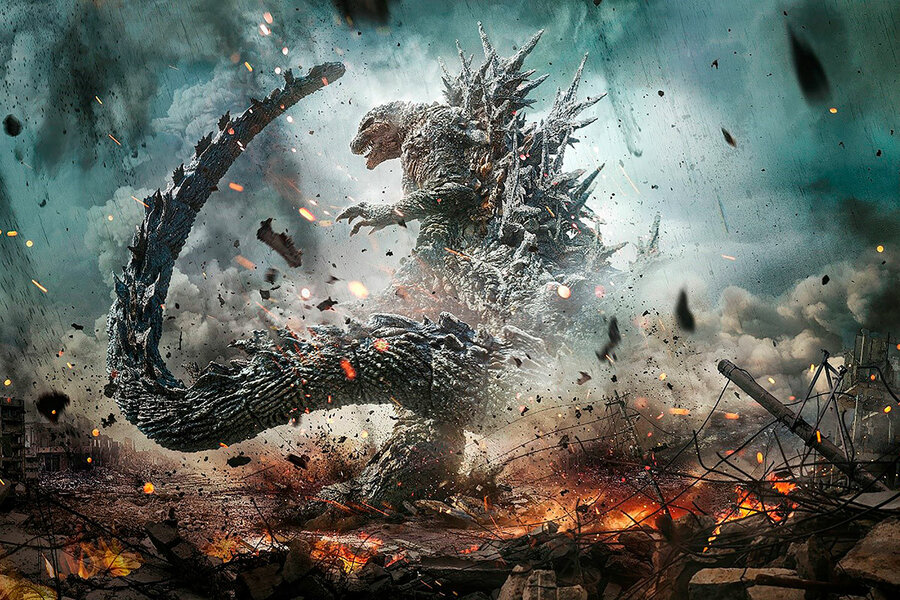‘Godzilla Minus One’: How a 70-year-old monster stays evergreen
| Boston
Godzilla has towered as a colossus of pop culture for nearly 70 years. Across three dozen movies, the titanic lizard has leveled city skylines with its atomic ray. Its destruction leaves audiences in awe, yet often eclipses the human plot. Until now. The latest iteration, “Godzilla Minus One,” is the 37th film starring the terrible tyrant. But it also might be the first one to make you care about the human characters.
In North America, “Godzilla Minus One” raked in more than $12.6 million in its first four days. Setting a new record for Japanese live-action films, it has become the highest-grossing foreign language film of the year, with a global take of $52 million after two weeks. It also has a 97% score from critics on Rotten Tomatoes, the highest of any Godzilla movie in the past three decades.
As with many monster movies, Godzilla’s enduring popularity hinges on its metaphorical meaning for society’s struggles. From its Cold War origins, Godzilla has always been a messenger of destruction. Over time, its symbolism has changed to address issues like nuclear weapons, environmental degradation, Japanese nationalism, and more. “Godzilla Minus One,” set right after World War II, instead tells an intimate human story with a minuscule budget. It’s a movie about redemption and how one man rediscovers meaning in his life.
Why We Wrote This
Where can people find faith in times of crisis? That search leads to the surprising heart of the newest Godzilla.
“What shines through, in the end, is a kind of warm humanism, in people rather than in organizations ... and the ultimate power of human relationships to endure and conquer everything, including a civilization-destroying monster,” says Bill Tsutsui, author of “Godzilla on My Mind: Fifty Years of the King of Monsters.” “Where can we put our faith as people in times of crisis? That’s in our family and in groups of like-minded people to come together and find solutions.”
Directed by Takashi Yamazaki, the film is set in the aftermath of World War II. The film is practically a love letter to the original 1954 “Godzilla” film, using its iconic soundtrack and Godzilla’s original earth-shaking roar. But it also returns to striking social commentary, covering themes of redemption, military duty, and sacrifice.
In the film, Japan has already been devastated by the war when a new crisis emerges in the form of a titan-sized terrible lizard. Viewers follow a kamikaze pilot who, in the final days of the war, abandons his suicide mission and flees to Odo Island, where he encounters a prehistoric reptile that the locals call Godzilla.
The film’s success among superfans and movie reviewers stems from the sense that “Godzilla Minus One” feels more like a war movie than your average Hollywood blockbuster.
Fans say that with the growing popularity of giant monster, or kaiju, movies, the human storylines are often forgettable. That’s not the case here.
Mr. Tsutsui says the film has a better human story, “perhaps than any other Godzilla movie ever made.”
The sincerity in the story pays off, Godzilla fans say. “Truthfully, the human story was more important than any other ‘Godzilla’ film that we’ve seen,” says Wayne Conway outside a Boston theater, sporting his favorite graphic T-shirt from the 2001 film, “Godzilla, Mothra, and King Ghidorah.”
“This movie is hands down the best Godzilla film I’ve ever seen,” says Josh Hernandez, who wore his own fan-made Godzilla sweatshirt to the theater.
“Godzilla Minus One” also stands apart due to its reported $15 million budget, which pales in comparison to $155 million for “Godzilla vs. Kong” (2021) and $180 million for “Pacific Rim” (2013).
In a panel at Tokyo Comic Con, Mr. Yamazaki said even that low budget for the current film was exaggerated, adding, “I wish it were that much,” according to user Kaiju No. 14 on X, formerly known as Twitter.
Far from its miniature sets and rubber monster suit origins, the new film has excellent visual effects.
Longtime Godzilla fan Sam Munoz says the small budget didn’t mean less mayhem. He says he’s never seen Godzilla so devastating, describing the creature as “catastrophic” and “a civilization-ending level threat.”
“You’re not watching a monster fighting other monsters. You are being chased by the monster,” says Mr. Tsutsui.
The original 1954 “Godzilla” offered a warning against the dangers of nuclear proliferation and the existential threat of nuclear annihilation. It arrived in the wake of the bombings of Hiroshima and Nagasaki by the United States and during the nuclear arms race between Russia and the U.S. In the new film, the creature’s origins tie in with nuclear testing in the Pacific Ocean and its atomic ray releases a mushroom cloud of destruction.
“We need Godzilla to do different things. We didn’t want it to just scare us,” says Mr. Tsutsui. “But how Godzilla scares us is going to change with where we are as a society in the world at any time. And the fact that Godzilla can continue to change and morph over the years means it’s truly an evergreen monster.”







